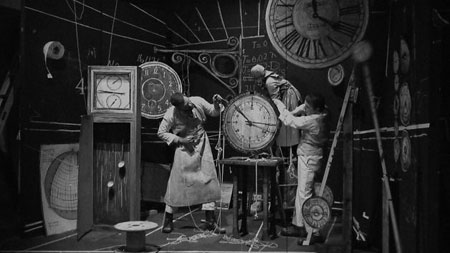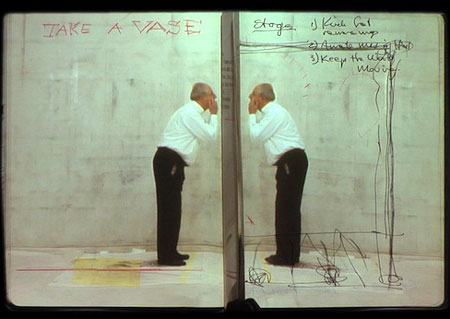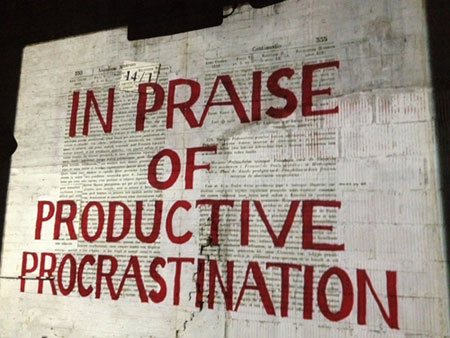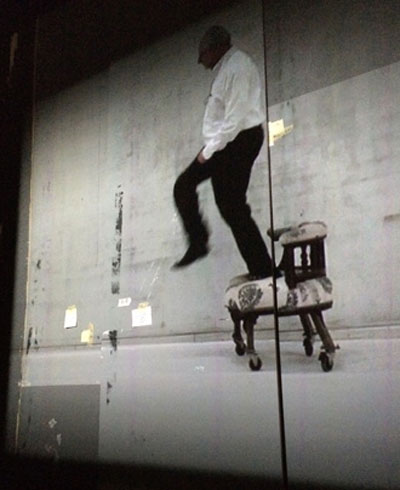|
Within a few gallery rooms of Pablo Picasso's portrait of Gertrude Stein at the Metropolitan Museum of Art is William Kentridge's installation, "The Refusal of Time." Newly acquired October 2013 by Met Art with the San Francisco Museum of Art, Kentridge's five-channel video exhibition brings new meaning to being in or achieving the continuous present, a concept dear to Stein's experimental writing.
What heightens being in the moment called now are several elements of the work: the videos, a large stationary sculpture with moving parts that Kentridge calls the breathing machine or elephant, and the broadcasting of music and sound from dispersed megaphones positioned around the room. The black-and-white videos, which are projected on three different walls of a dimly lit room, often pick up where the one before it stops. Thus a parade of black musicians and dancers start on the left wall and "jump" from one video projection spot to the next as the players make their way around the room to the far right wall.
Meanwhile in the center of the room moves the wooden sculpture that has a late 1890's factory look about it, but initially reminded the Steiny Road Poet of an old oil drilling rig. Kentridge said the concept of his elephant springs from Charles Dickens in his novel Hard Times where he depicts industrial machines "moving up and down, like the movement of the head of an elephant in a state of melancholy madness." Dispersed at odd angles around the breathing machine are chairs bolted to the floor. Museumgoers who sit in these chairs become part of the theatrical landscape and often startle those walking through the exhibit who think what is sitting in the chairs are inanimate objects—that is, until the mesmerized but sitting visitor moves.
This business of breathing is explored at various levels from the sublime (the course of human life and death) to the ridiculous. In conceptualizing the work, Kentridge learned about a system of copper pipes under the streets of Paris at the turn of the 20th century. By sending air through these pipes, clocks at various locations in Paris and hooked into this piping could be jarred and therefore set to the correct time.
Then Kentridge experimented with compressors, rubber lips and tubas in attempt to play two of these musical instruments without the help of human tuba players. He said the best sound he could get was a "terrible loud fart" so this aspect of the project went into the "Room of Failures." However, the music of "The Refusal of Time" is heavy on the sound of the tuba and it lends an elephantine whimsy to the soundscape. These loose connections are reminiscent of Gertrude Stein's Tender Buttons, which Steiny is studying with an international group of poetry fans. Among these fans is journalist Mary Armour, a South African keen on the work of fellow South African William Kentridge. In an email exchange between Steiny and Armour, Armour wrote,
 |
"Kentridge's demarcation of time would have impacted on Gertrude Stein in a 'modernised world' of cables, bleus [petit bleu messages], pneumatic pumps and telegraphs, speaking phones and cameras, electric wires and Marconi's radio, the way colonialism divided up the colonised worlds into segments of time, ways of controlling time globally as a way of refusing death, monitoring and controlling time in war (remember that the French Imperial Prince dies at the Anglo-Zulu battle of Isandlwana in 1879 because of miscalculations of time needed to send for reinforcements, time needed for marching, etc.) and the British will try to control time very differently in the Anglo-Boer war of 1899-1902. This is a fascinating topic—how do you fight long-distance wars unless you are a master of time? How can communications outrun time? What happens to time when we chop it up or refuse to acknowledge the existence of black holes?
 |
"What happens when a woman in 1912 begins to use the continuous present and refuses certain conventions of verbs and time in language?"
Stein began writing Tender Buttons in 1912. In this clandestine love poem, she used her keen seen of scientific observation, learned first at Harvard and continued in her four years of medical studies at Johns Hopkins University.
Kentridge's project partially came from conversations he had with American historian of science Peter Galison, who teaches in the physics department at Harvard University. In the spring of 2012, Kentridge was a guest speaker at Harvard in the Norton Lecture Series. Kentridge began his six lectures with Plato's cave and ended with black holes. Named a Catherine T. MacArthur Foundation Fellow in 1997, Galison specializes in "the intersection of philosophical and historical questions such as: What, at a given time, convinces people that an experiment is correct? How do scientific subcultures form interlanguages of theory and things at their border?" Had Gertrude Stein's Harvard teacher William James been contemporary with Galison surely they would have had a lot to discuss—as would Stein and Kentridge—as would the four of them together. Kentridge names Galison as one of his collaborators for "The Refusal of Time" and in his production credits calls Galison dramaturge.
 |
"My job is to make art not sense," Kentridge has said. According to his learned introducer on the occasion of his first Norton lecture, Kentridge's art "emerges from gaps, inversions, in between spaces, and interrupted times somewhere between what we see on The Wall and what we conjure up behind our retinas— between recognition and representation lies a way of knowing and looking. It can be lost or gained in the blink of an eye. Look carefully. Nothing remains quite the same. Anything is possible." As a video recording of the first lecture reveals, the over imprinted pages (Kentridge painted terse phrases in block letters over pages ripped from 17th century book) appear in the videos of "The Refusal of Time." The phrases read with such words as: a practical epistemology,the shadow of the enlightenment, against argument (but not this one), what we learnt at supper, the pleasures of self deception, in praise of productive procrastination,defensive sleeping, in praise of bad clocks, poems I used to know…
 |
Kentridge's view of the world for this exhibition includes metronomes that at first look synchronized but then go rogue with their own sense of time and rhythm, five simultaneous but different laboratories where it seems a bomb is being made, a slapstick melodrama between a loveless married couple and her lover, various meta moments where paper is cut and becomes a dancing figure, a scrolling of the cutouts that make a player piano produce music, the artist Kentridge repeatedly walking over an upholstered chair or standing at the edges of video frames as if he is looking into a mirror. How the title comes about is related to the 1894 attack on the Greenwich Observatory where Greenwich Mean Time is set. The thirty-minute run of the five video projections goes by quickly and the Steiny Road Poet saw the projections three times before getting dragged away by an artist friend who needed to get back to Brooklyn to care for her dog.
Real life and the life of the mind blend like this in Kentridge's "The Refusal of Time" and in Stein's Tender Buttons. "The Refusal of Time" runs through May 11, 2014 at the Metropolitan Museum of Art. The rumor is that the San Francisco will reopen and feature "The Refusal of Time" but, hélas, that won't be until 2016. So, Dear Steinians, on your way to see Picasso's portrait of Gertrude, see if you can catch the genius of William Kentridge's "The Refusal of Time."
|